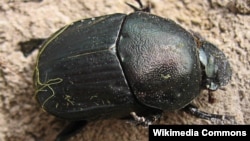The lowly dung beetle uses a “snapshot” of the stars to navigate.
Researchers at Lund University say the insects “use the light of the Milky Way to navigate in the world.”
Dung beetles build and then mount balls of animal waste, upon which they "dance" - spinning around - and then roll it, in a straight line, back to their lair where it is used as food and a nursery for their offspring.
Researchers say the beetles are able to navigate by taking a “snapshot” of the stars and their positions.
"Other animals and insects also use the position of celestial bodies to navigate, but the dung beetles are unique - they are the only ones to take a snapshot where they gather information about how various celestial bodies, such as the sun, moon and stars, are positioned", said Basil el Jundi, a researcher at Lund University.
The researchers added that just one snapshot gives the beetles all the information they need to navigate.
This is not the first study to show that beetles use celestial bodies to navigate, but it is the first to show that they take a single snapshot and store that information in their brains.
Globally, there are thousands of species of dung beetles, all of which exhibit the dung rolling behavior.
The research was done in South Africa at a lab with an artificial sky. That allowed researchers to adjust the amount of light and locations of stars and other heavenly bodies.
According to the BBC, the researchers found that beetles can see things in the sky that humans can’t, such as “the spectral gradient of the sky and polarized light.”
"Just using the Sun for example, if there's a cloud, the beetle would be lost," el Jundi told the BBC. "You need to add a lot of cues into the system to make it robust, and that is why they use as many celestial cues as possible."
El Jundi added that the discovery could lead to the creation of navigation systems for driverless cars.
Here's a short video of a dung beetle dancing on a ball of dung:









